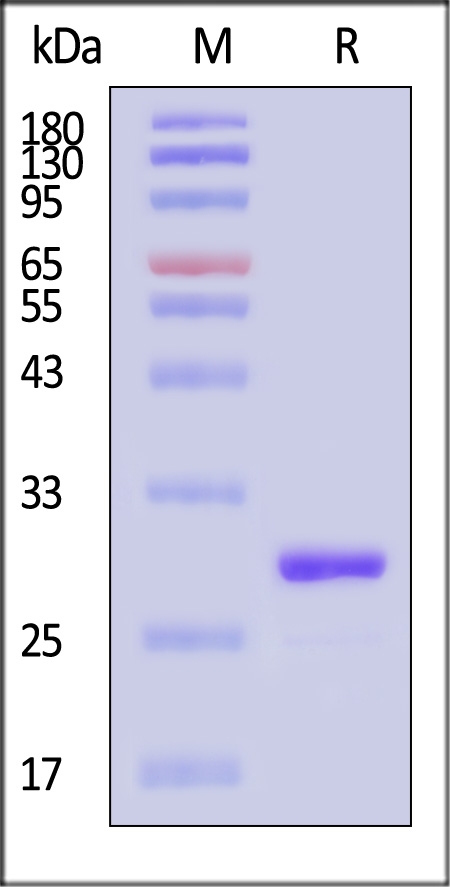分子别名(Synonym)
Apolipoprotein A-I,APOA1,MGC117399
表达区间及表达系统(Source)
Human Apo-A1, His Tag (AP1-H5225) is expressed from human 293 cells (HEK293). It contains AA Arg 19 - Gln 267 (Accession # NP_000030.1).
Predicted N-terminus: Arg 19
Request for sequence
蛋白结构(Molecular Characterization)

This protein carries a polyhistidine tag at the C-terminus.
The protein has a calculated MW of 29.8 kDa. The protein migrates as 27 kDa when calibrated against Star Ribbon Pre-stained Protein Marker under reducing (R) condition (SDS-PAGE).
内毒素(Endotoxin)
Less than 1.0 EU per μg by the LAL method.
纯度(Purity)
>95% as determined by SDS-PAGE.
制剂(Formulation)
Lyophilized from 0.22 μm filtered solution in PBS, pH7.4 with trehalose as protectant.
Contact us for customized product form or formulation.
重构方法(Reconstitution)
Please see Certificate of Analysis for specific instructions.
For best performance, we strongly recommend you to follow the reconstitution protocol provided in the CoA.
存储(Storage)
For long term storage, the product should be stored at lyophilized state at -20°C or lower.
Please avoid repeated freeze-thaw cycles.
This product is stable after storage at:
- -20°C to -70°C for 12 months in lyophilized state;
- -70°C for 3 months under sterile conditions after reconstitution.
电泳(SDS-PAGE)

Human Apo-A1, His Tag on SDS-PAGE under reducing (R) condition. The gel was stained with Coomassie Blue. The purity of the protein is greater than 95% (With Star Ribbon Pre-stained Protein Marker).
背景(Background)
ApoA1 is also known as apolipoprotein A-I, ApoA-I , and is the major protein component of high density lipoprotein (HDL) in plasma. It has a specific role in lipid metabolism. Chylomicrons secreted from the intestinal enterocyte also contain ApoA1 but it is quickly transferred to HDL in the bloodstream. The protein promotes cholesterol efflux from tissues to the liver for excretion. It is a cofactor for lecithin cholesterol acyltransferase (LCAT) which is responsible for the formation of most plasma cholesteryl esters. ApoA-I was also isolated as a prostacyclin (PGI2) stabilizing factor, and thus may have an anticlotting effect. Defects in the gene encoding it are associated with HDL deficiencies, including Tangier disease, and with systemic non-neuropathic amyloidosis. In addition, it has been shown that ApoA1 is implicated in the anti-endotoxin function of HDL via interaction with lipopolysaccharide or endotoxin.























































 膜杰作
膜杰作 Star Staining
Star Staining











